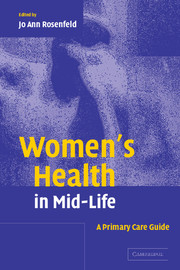Book contents
- Frontmatter
- Contents
- List of contributors
- 1 Introduction
- Part I Health promotion
- Part II Hormonal changes
- Part III Disease prevention
- Part IV Cancer prevention
- 16 Breast cancer: screening and prevention
- 17 Cervical cancer: prevention, screening, and early detection
- 18 Endometrial cancer: prevention, screening, and early detection
- 19 Ovarian cancer: prevention, screening, and early detection
- 20 Colon, lung, and skin cancer: screening and prevention
- 21 Common gastrointestinal and urinary problems
- Index
- References
16 - Breast cancer: screening and prevention
from Part IV - Cancer prevention
Published online by Cambridge University Press: 21 August 2009
- Frontmatter
- Contents
- List of contributors
- 1 Introduction
- Part I Health promotion
- Part II Hormonal changes
- Part III Disease prevention
- Part IV Cancer prevention
- 16 Breast cancer: screening and prevention
- 17 Cervical cancer: prevention, screening, and early detection
- 18 Endometrial cancer: prevention, screening, and early detection
- 19 Ovarian cancer: prevention, screening, and early detection
- 20 Colon, lung, and skin cancer: screening and prevention
- 21 Common gastrointestinal and urinary problems
- Index
- References
Summary
Introduction
Breast cancer has the highest incidence and the third highest death rate for cancer in women in the USA. More than 200 000 women annually develop breast cancer in the USA. The incidence of breast cancer increased between 1973 and 1998 by 40%, perhaps caused by an increase in early-stage breast cancer detection. A woman in the USA has approximately a one in eight risk of developing breast cancer in her lifetime. The incidence of breast cancer increases with age, making screening more important in middle-aged women.
Unlike with lung cancer, screening programs and early detection for breast cancer have reduced its mortality. No studies have found a method to prevent breast cancer. Thus, early detection to reduce mortality is essential. The fact that early detection with mammography reduces mortality in women aged 50–69 years has been accepted and established. However, controversies about the efficacy of screening with different methods and in different populations have occurred; newer studies may be reported in the near future that may reduce or increase these disputes. Evaluation of previous investigations is, thus, important.
Presentation
The most common presentation of breast cancer is no symptoms. The first symptom is often a small, painless nodule or pain. Other symptoms include skin changes, dimpling, and nipple discharge.
Case: a 48-year-old woman comes to the office for an episode of acute bronchitis. After history and examination, you notice that there is no note of any breast cancer screening, including mammography, on her chart. You suggest a mammogram, but she says, “Hasn't that proven lately not to be accurate?”
Keywords
- Type
- Chapter
- Information
- Women's Health in Mid-LifeA Primary Care Guide, pp. 275 - 286Publisher: Cambridge University PressPrint publication year: 2004



